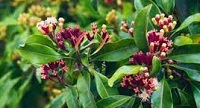Antihyperlipidemic potential of Eugenia caryophyllus extract in Wistar rats
Keywords:
Triton, hyperlipidemia, Atorvastatin, Eugenia caryophyllusAbstract
Objective: The present study was aimed to evaluate the antihyperlipidemic activity of the aqueous ethanolic extract of Eugenia caryophyllus in triton induced hyperlipidemia. Methods: Antihyperlipidemic activity was evaluated using Triton X 100 induced hyperlipidemia in rats as an experimental model. Hyperlipidemia was induced in rats by a single intraperitoneal (ip) injection of Triton X 100 (400 mg/kg b.w.) The aqueous ethanolic extract of Eugenia caryophyllus extract was administered at two different doses of 200mg/kg and 400mg/kg for 7 days to hyperlipidemic rats. Atorvastatin was used as a reference standard. Serum triglycerides, total cholesterol, HDL-C, LDL-C and VLDL-C, atherogenic index and glucose were determined to assess the antihyperlipidemic activity. Result: It was found that the aqueous ethanolic extract of Eugenia caryophyllus at the doses of 200mg/kg and 400mg/kg showed a significant decrease in the levels of serum total cholesterol, triglycerides, LDL-C, VLDL-C, glucose and significant increase in the level of serum HDL-C. Conclusion: The current study provided a strong evidence that the Eugenia caryophyllus extracts at both the doses (200mg/kg and 400mg/kg) possess significant antihyperlipidemic activity. The dose of 400mg/kg had a higher beneficial effect and its efficacy was similar to that of Atorvastatin in treating hyperlipidemia. However, further study is needed to understand the precise mechanism.
References
Grundy SM. Cholesterol and coronary heart disease: a new era. J Am Med Assoc. 1986; 256: 2849-2858.
WHO. Preventing chronic diseases: A vital investment. 2005. [accessed April 23, 2009]. http://www.who.int/chp/chronic_disease_report/full_report.pdf.
Davey Smith G. Cholesterol lowering and mortality: the importance of considering initial level of risk. Int Med J. 1993; 306:1367-1373.
Farmer JA, Torre-Amione G. Comparative tolerability of the HMG-CoA reductase inhibitors. Drug Saf. 2000;23:197–213.
Lipscombe J, Lewis GF, Cattran D, Bargman JM. Deterioration in renal function associated with fibrate therapy. Clin Nephrol. 2001;55:39–44.
Speight, T.M., 1987. Avery’s Drug Treatment: Principles and Practice of Clinical Pharmacology and Therapeutics. 3rd Edn., ADIS Press Ltd., New Zeland, pp: 599-610.
Chaieb K, Hajlaoui H, Zmantar T, Nakbi ABK, Rouabhia M, Mahdouani K et al. The chemical composition and biological activity of essential oil, Eugenia cryophyllata (Syzygium aromaticum L. Myrtaceae): a short review. Phytother Res. 2007;21(6): 501-506.
Duraipandiyan V, Ayyanar M, Ignacimuthu S. Antimicrobial activity of some ethnomedicinal plants used by Paliyar tribe from Tamil Nadu India., BMC Complement Altern Med. 2006;6: 35.
Fu Y, Zu Y, Chen L, Shi X, Wang Z, Sun S et al. Antimicrobial activity of clove and rosemary essential oils alone and in combination. Phytother Res. 2007;21: 989–994.
Park MJ, Gwak KS, Yang I, Choi WS, Jo HJ, Chang WJ et al.Antifungal activities of the essential oils in Syzygium aromaticum (L.) Merr. Et Perry and Leptospermum betersonni Bailey and their constituents against various dermatophytes. J Microbiol. 2007;45: 460-465.
Cai L, Wu CD. Compounds from Syzygium aromaticum possessing growth inhibitory activity against oral pathogens. J Nat Prod. 1996;59(10): 987-990.
Miyazawa M, Hisama M. Antimutagenic activity of phenylpropanoides from clove (Syzygium aromaticum). J Agric Food Chem. 2003;51(22): 6413-6422.
Magalhaes CB, Riva DR, DePaula LJ, Brando-Lima A, Koatz VL, Leal-Cardoso JH et al. In vivo anti-inflammatory action of eugenol on lipopolysaccharide-induced lung injury. J Appl Physiol. 1985;108(4): 845-851.
Li Y, Xu C, Zhang Q, Liu JY, Tan RX. In vitro anti-Helicobacter pylori action of 30 Chinese herbal medicines used to treat ulcer diseases. J Ethnopharmacol. 2005;98(3): 329-333.
Bae EA, Han MJ, Kim NJ, Kim DH. Anti-Helicobacter pylori activity of herbal medicines. Biol Pharm Bull. 1998;21(9): 990-992.
Srivastava KC, Malhotra N. Acetyl Eugenol, a component of oil of cloves (Syzygium aromaticum) inhibits aggregation and alters arachidonic acid metabolism in human blood platelets. Prostaglandins Leukotrienes and Essential Fatty Acids. 1991;42: 73-81.
Cosa P, Vlientinck AJ, Berghe DV, Maes L. Anti-infective potential of natural products: How to develop a stronger in vitro ‘proof-of-concept’. J Ethnopharmacol. 2006; 106: 290-302.
Pourgholami MH, Kamalinejad M, Jayadi M, Majzoob S, Sayyah M. Evaluation of anti-convulsant activity of essential oil of Eugenia caryophyllata in male mice. J Ethnopharmacol. 1999;64(2): 167-171.
Kumaravelu P, Subramaniyam S, Dakshinamoorthy DP, Devaraj NS. The antioxidant effect of eugenol on CCl4-induced erythrocyte damage in rats. J of Nut Biochem. 1996;7(1): 23-28.
Singh AK, Dhamanigi SS, Asad M. Anti-stress activity of hydro-alcoholic extract of Eugenia caryophyllus buds(clove). Indian J Pharmacol. 2009;41: 28-31.
Hossseini M , Kamakar M ,Rakhshandeh H. Analgesic effect of clove essential oil in mice. Avicenna Journal of Phytomedicine. 2011;1(1): 1-6.
Kamkar A Nazaribourun A, Hosseini M. Analgesic effect of aqueous and ethanolic extracts of clove. Avicenna Journal of Phytomedicine. 2013;3(2): 186-192.
Srivastava KC. Antiplatelet principles from a food spice clove (Syzgium aromaticum). Prostaglandins Leukotrienes and Essential Fatty acids 1993;48: 363-372.
Kokate CK, Purohit AP, Gokhale SB. Pharmacognosy. 41st ed. India: Nirali Prakashan; 2008.
Harborne JB. Phytochemical Methods, a guide to modern techniques of plant analysis. 3rd ed. UK: Springer; 1998.
Sasidharan S, Chen Y, Saravanan D, Sundram KM, Latha LY. Extraction, isolation and characterization of bioactive compounds from Plant extracts. Afr J Tradit Complement Altern Med. 2011;8(1):1-10
Trease E, Evans WC. Pharmacognosy William Charles Evans, 15th ed., Saunders Publisher, London, 2004, 137-440.
OECD, 2002. Acute oral toxicity. Acute oral toxic class method guideline 423 adopted 23.03.1996. In: Eleventh Addendum to the, OECD, guidelines for the testing of chemicals organisation for economical co-operation and development, Paris, June, 2000.
Nanumala SK, Nischal Y, Sarika M, Shravaya SS. Hypolipidemic activity of ethanolic extracts of Cassia angustifolia in Triton X 100 induced hyperlipidemia in rats. Asian J Pharm Clin Res. 2014;7 (1):189-191.
Byers SO, Fiedman M, and Sugiyama T. Triton hypercholesteremia: cause or consequence of augmented cholesterol synthesis. Am J of Physiol 1963;204:1100–1102.
Schurr PE, Schultz JR, Parkinson TM. Triton induced hyperlipidemia in rats as an animal model for screening hypolipidemic drugs. Lipids.1972;7:69-74.



